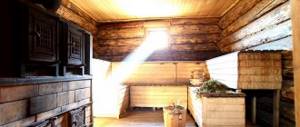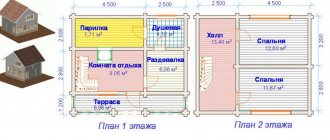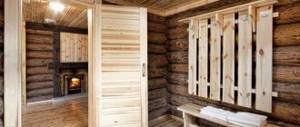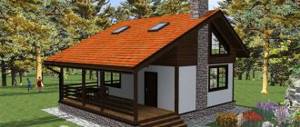photo from billionnews.ru
If you decide to build a bathhouse yourself, start by drawing up a construction plan. It will help you calculate how much material will be needed for the frame, interior and exterior decoration, correlate the future building with other buildings located on the same land, and understand how to properly build a heating system. By abandoning a project, you risk making irreparable mistakes. One of them may be incorrect sizing calculations. Our article will tell you what the optimal height of a bathhouse from floor to ceiling should be according to the standard, what the dimensions of the shelves are, and why these criteria are so important.
What height: is there a dependence on the wall material?
Bathhouses nowadays are built from any available material. This includes a classic log frame or timber, brick, and new (relatively) cellular concrete - aerated concrete, foam concrete, and cinder blocks. Another option that comes across quite often is frame.
Are there any differences in ceiling height in a bathhouse made of timber or a bathhouse made of blocks?
In a bathhouse made of blocks, timber, frame
Specific numbers are discussed below, but here we will simply say that:
ATTENTION! The material of the walls does not matter when choosing the height of the bath from floor to ceiling.
In fact, it’s not a matter of saving material when making a low structure. In practice, everything in the bathhouse is functional, including its dimensions.
Optimal entrance sizes, what they depend on and which ones to choose
The main purpose of the entrance door to the bathhouse is not only heat preservation, but also reliability. It can be performed in the following options:
- Wooden. The most optimal option, it perfectly retains and retains heat inside the room; it is necessary to monitor the condition of the door leaf to avoid deformation and the appearance of mold. It is recommended to treat with special compounds for wood.
- Metal. It will reliably preserve the owner’s property; if there is an additional seal and the cladding is practically in no way inferior to wooden. The handles on such a door must be made of wood to avoid inconvenience, for example, when going out in the cold.
- Plastic. The simplest and most convenient, but its use is allowed only in cases where the bathhouse is located in close proximity to the house, because it can be easily opened.
Attention! For maximum convenience, use only wooden handles to avoid burns or unwanted sticking in the cold.
The choice of the size of the entrance door to the bathhouse is purely individual, but if you stick to the classic version, the following dimensions of the doors for the bathhouse are considered the most optimal - 1.80 x 0.65 cm, it should only open outward. It is imperative to install a threshold with a height of at least 15 cm. If possible, from the inside it should coincide with the upper edge of the floor, only in this case a gap will be formed that will work as a hood.
There are no strict requirements for the material, so you can use classic 5-centimeter tongue-and-groove boards or use ready-made samples. For better heat retention, you can additionally cover the door with insulation or make a box at least 10 cm wide.
What should be the optimal setting in a steam room: is there a standard?
Let's start with the fact that our main room is the steam room . And what the height of the ceiling in the bathhouse should be depends on the height of the ceiling in the steam room.
There is still no standard. There is something like a stereotype that most sources recommend sticking to - it is 2 or 2.2 meters. Or 2.1 m. However, it must be checked through the dimensions of your shelves, oven dimensions and much more.
But what exactly are these numbers related to? Well, of course, first of all, with a person’s growth. And height already affects the height at which the raised hand with a broom will be, which is an important point for a Russian bathhouse, because you don’t need to stretch too hard for the steam either . There are different criteria in a sauna, but both are discussed below.
Secondly, they are related to the rate of heating of the steam room to the desired temperature. This is where saving resources becomes important. It is clear that the smaller the volume of the room, the faster it heats up. But in everything it is worth observing moderation, so it is believed that 2 meters is the optimal ceiling height in a steam room in a bathhouse specifically from the point of view of heating.
More information on ceilings in the steam room here.
Shelf installation height
Separately, it is worth mentioning the height of the shelves in the case of a pie atmosphere. Anyone who wants a good steam wants to go higher up to the steam cloud because it is much warmer there. However, in such conditions it becomes difficult to operate the broom with raised hands. Incredible heat causes muscles to quickly tire, which significantly reduces the quality of bathing procedures.
In this regard, they try to install the shelves slightly lower than the bath attendant wishes, and slightly higher than the level convenient for the bath attendant - approximately 80 cm from the level at which the bath attendant stands. Initially, the width of the shelves in the bathhouse should be chosen correctly.
If you plan to create only a pie atmosphere in the bathhouse, then you can make a second tier if you plan to steam alone. This will make it possible to reach the steam and direct it along your body without anyone’s help or a broom. It will not be possible to provide uniform heating throughout the entire steam room in this mode, but this is not so scary. There is no point in installing a third tier, since it is impossible to withstand even a minute at such a height.
However, it is worth noting that almost 100% of all those who like to take a bath prefer to create an air-conditioned microclimate. This is because it is easier to achieve and maintain. In addition, you need to take into account that for a pie atmosphere you need to install a very powerful stove with a large heater so that you can lay a lot of stones, and, accordingly, you need a lot of firewood.
The room being equipped must be large in size, and the optimal ceiling height in the bathhouse, that is, in its steam room, should be at least 2.4 m. To ensure such bathing conditions, one cannot do without a large, powerful modern brick stove. That is, we can say that this option is quite expensive.
Bathhouse with a high ceiling: will it be good?
In principle, everything has the right to exist, including a bathhouse with a high ceiling. In this case , the power of the stove, the mode of the bath or sauna, the design and height of the shelves are simply compared (more on this below). These are the main factors that should be taken into account.
Warm air tends upward, cold air - downward. This is related to the number of molecules per unit volume. But it is important for us that increasing the height of the ceiling in the steam room of the bathhouse leads to an increase in the temperature difference above and below. The gradient is stretched. This can only be compensated with the help of properly arranged ventilation. (You can read about it in this section.)
But in the Russian tradition, ventilation must be turned off when steam is supplied . Therefore there is less freedom or arbitrariness. Roughly speaking, you are connected by the ability of your furnace to produce superheated steam, which is reflected in the thickness of the “steam cake,” and the growth of the steam. The latter can be easily adjusted with the help of stands and the shelf design in general. Problems with cold below are solved, for example, with the help of heated floors.
IMPORTANT! A high ceiling can be allowed in a sauna with good ventilation and in a Russian bath with powerful steam generation in a closed heater.
Microclimate of a Russian bath
Experts, and simply knowledgeable people, distinguish two modes that can be used in the steam room of a Russian bath: conditioning and pie. They have some differences, and the height of the ceilings depends on them, so it’s worth talking about this in more detail.
During the production of steam in the steam room, you can create several modes. In the first case, the steam is evenly distributed throughout the room, while the humidity level and temperature are also distributed evenly, slowly increasing towards the ceiling.
This mode is called conditional. In this case, it is advisable to install shelves in several levels - this level is individual for each person, but the higher they are installed, the hotter the air will be.
The second mode is characterized by a sharp stratification and differentiation of humidity and temperature indicators, while a cloud of steam accumulates under the ceiling, which does not mix with the entire volume of air. Even after trying to push part of the cloud down with your hands, it will immediately return back.
In this regard, heat is applied to the body using brooms. They are lifted up, warmed up a little, and with the steam accumulated between the leaves, the heat is directed along the body. You can simply move waves of hot air to the desired location with frequent movements. As a result, a person experiences unforgettable sensations, but it is extremely difficult to create such a microclimate.
What should be the minimum amount in a steam room?
We have already practically answered this question. If we take into account the options where the steam room is designed for 1-2 people, and it is also a sauna, then the very minimum is 40-60 cm on the shelves for sitting (60 is 40 + 20 cm of space), plus the standard 110 cm from ceiling to shelf height. The total is 150-170 cm, but this conflicts with the height of an ordinary person and the need to have at least 20 cm of free space above the head.
So in the described case with a sauna, we would say that the minimum height of the ceiling in the steam room should be the height of the tallest owner plus 20 cm .
Why is this type different from interior ones?
Today, in almost any suburban area or dacha you can find a bathhouse. In most cases, it is erected independently, without turning to specialists. And, if everything is clear with the design and general requirements. The question may quite naturally arise - what kind of door to the steam room should be in the bathhouse? Are there any fundamental differences from the standard interior? What are the basic requirements for materials and characteristics?
The main differences from standard doors include:
- Good thermal insulation;
- Increased heat resistance;
- Moisture resistance.
The entrance door of the bathhouse may not meet all of the listed requirements. Its main purpose is thermal insulation and heat preservation. Therefore, the standard one can also be used. Doors for a steam room in a bathhouse must meet the listed requirements and are made using special technology.
Solid wood is always used for production, because... The classic technology for producing interior doors is not suitable. Heat-resistant glass can be used; plastic is not suitable for the door to the steam room. Of the wood species, preference is given to linden, aspen and larch; the use of pine is allowed.
Previously, for better heat retention, smaller openings were used. Now this rule has practically lost force; it is allowed to install a door of a standard size. In rare cases. You can find a door of reduced size, which requires you to bend down when passing through it.
Tempered glass has become widespread. You don’t need to make it yourself; it’s enough to know the necessary parameters of the sauna door and its dimensions. You can buy a ready-made sample of a glass door in stores that specialize in bath materials.
Distance from shelf/shelves to ceiling
The designs of the regiments vary depending on their purpose. There are two different types of treatments - sweating and steaming. In the first case, it is enough for a person to sit, blown with dry and hot air, which forces the body to release moisture; in the second, the recipient of the procedure must lie down, and the steaming itself is carried out using brooms and superheated steam.
Therefore, the design of the shelves differs according to the Russian and Finnish traditions. They are fundamentally different, and their height is also different, because the number and arrangement of tiers are different. I wouldn’t like to repeat myself, so for those who need specifics about the different heights of shelves in a bathhouse from the ceiling, we suggest reading this article. And you can also have this one: Dimensions: shelves in the steam room, ceilings, windows and doors, as well as the optimal area of the premises - steam room and washing room.
What you need to make your own wooden
Anyone can make their own wooden steam room doors. You need to follow simple instructions. First of all, you need to prepare the necessary tools:
- screwdriver;
- roulette;
- plane;
- pencil;
- level;
- saw or hacksaw;
- milling cutter
Important! Making a steam room door with your own hands should be done on an absolutely flat surface to avoid inaccuracy.
What wood to make it from?
The choice of wood type is individual; there are no clear boundaries. The main requirement is resistance to high temperatures and durability. Conditionally wood for making doors for steam rooms. Can be divided into two categories:
- deciduous species - alder, linden, aspen and oak;
- conifers - larch, cedar, spruce, pine.
Information! Conifers can produce resin, which may not be pleasant. However, this feature goes away on its own after a couple of years of using the steam room. .
The main advantage of the latter is the low price, ease of processing and manufacturing of the necessary structures. The most common is linden. It is used not only for the manufacture of doors, but also for the internal lining of the steam room. Compared to others, linden is simple and easy to process, and does not warp or shrink over time. The aesthetic appearance of the wood is also important - a delicate creamy shade, without knots or wormholes.
Making a box
When making a door to a steam room with your own hands, you need to know how to make it and install the door frame. To do this, you will need a wooden beam with a cross-section of 6x15 cm; the material should be selected in such a way that the thickness of the door leaf is at least 5 cm less than the width of the frame.
The elements are fastened using the tongue-and-groove method. The bath door must necessarily swing outward, so the joining grooves must be cut out on the outside of the crossbars. They are cut out on the top and side posts in the doorway.
Before the box is assembled, it is necessary to sand the entire surface with sandpaper to remove all irregularities and chips. Then connect the lintels and corners, and then check the assembled structure with a level to avoid future distortions and sagging of the door.
Making canvas from treated boards
After the dimensions of the door to the steam room in the bath are determined, we begin to manufacture the canvas. A board with a length of at least 164 cm is used; the protruding tenon is cut off from the first board with a circular saw to form an even end. All manipulations are carried out only on a flat surface, assembly using the tongue-and-groove method, and the width of the workpiece should be greater than the size of the future door.
After everything is prepared, the final assembly of the canvas is carried out using PVA glue. First, it is recommended to lay out the prepared boards together and make sure they are the same length.
During the assembly process, it is necessary to knock the boards with a hammer so that the grooves are better secured, after which it is necessary to leave it for several days, first securing it or creating a press effect. Then you need to cut a piece of the required size from the canvas and process it with a plane.
If gaps appear, they can be immediately sealed using a mixture of glue and sawdust. The final stage will be attaching the strapping and installing stiffening ribs, which are located outside across the canvas. After that. Once the door is ready, it must be coated with special protective compounds that will protect it from the formation of mold and rot.
Using moldings, you can give the room a finished look, especially in cases where the size of the doorway differs from the door. All necessary materials are baseboards. Thresholds and other things can be purchased in specialized stores.
conclusions
The dimensions required for a bathhouse door with a frame can be made by anyone. To do this, you don’t have to be a specialist, the main thing is to select all the necessary materials and follow simple instructions. In order for it to serve for many years, it must be done efficiently, taking into account all requirements and safety.
The requirements for the front door are a little simpler than for the door to the steam room; the dimensions of the latter differ significantly from the generally accepted ones. This is necessary to retain heat. Door fittings must be exclusively wooden, except for door fastenings. Bathhouse doors should only swing outward, this applies to both the entrance door and the rest of the bathhouse doors.
Features of national traditions
Unfortunately, many people try to focus on the “arithmetic mean” between the sauna and the Russian tradition. This is also facilitated by the fact that the most common ones in our country are still iron stoves, suitable for saunas and requiring casings and closed heaters for a Russian bath.
That’s why, by the way, the shelves are made the ones you like best, and not the ones that suit a certain regime.
And as a result, it turns out that the bathhouse becomes dangerous to health, because it has a high temperature at the same time as high humidity, and the room itself does not meet the requirements of any regime.
In Russian
As mentioned above, the determining value for the entire structure will be the height of the ceiling in the steam room of a Russian bath.
Shelves in a Russian bath
In the steam room
Let's start with the fact that water poured onto stones heated to a temperature of several hundred degrees turns into superheated steam, that is, having a temperature of more than 100 degrees. It is different from the steam that comes out of a boiling kettle. Superheated steam is drier and finer.
And this steam rushes up and remains there, because it has nowhere to go. The cloud of steam near the ceiling is called a " steam cake ". The thickness of this steam cake is usually taken to be 50-60 cm.
BY THE WAY! That is why the door to the steam room is made low so that steam does not escape through it.
The head of the steamer is immersed in the steam cake, but for the sake of the person it would be worth making sure that his head is not in the hottest part. Yes, it won’t turn out to be if everything is done according to the rules.
So, the sailor can stand on the floor, or maybe on a step. Depending on this, the distance from his head to the ceiling in the bathhouse changes. Plus, he should also be able to raise his hand and scoop up steam from the very top layer of the “pie” with a broom.
If you estimate it like this, then the height of 2.2 meters will not seem excessive. Subtract 50-60 cm , you get 160-170 cm - at this distance from the floor the steam cake will begin. It’s quite possible to make a little attack, because the bottom layer will not be too hot.
In sauna
In a Finnish sauna, as already mentioned, the ventilation is good, the air flow from the street quickly heats up and moves further through the steam room space. But even there it will be hottest at the top. Therefore, the Finns prefer to make their shelves three-tiered, reserving the last tier for the most “heat-resistant” visitors to the steam room.
Sauna
The ceiling height in the sauna consists of the height of the shelf and the 110 cm above it allocated for the normal sitting position . Let's try to estimate: if we have three tiers, and each of them is 40 cm, then we get: 40 * 3 + 110 = 230 cm.
Well, it turned out almost the same as for the Russian steam room. We can say that a value in the region of 2.2-2.3 meters is, from our point of view, the optimal height of the bathhouse from floor to ceiling.
Correct height of bath ceilings
Features of bath ceilings:
- The standard height of a bathhouse from floor to ceiling can be from 210 to 240 cm. It depends on the size of the building and the height of the shelves.
- Heating a standard bathhouse will require half as much fuel and time as heating a large building.
The optimal height for a bathhouse is considered to be from 220 to 240 cm. Low ceilings lead to an increase in the area of the premises and an increase in fuel consumption for heating them.
To regulate the soaring conditions, it is better to install the shelves in several levels. This arrangement will allow visitors to independently choose the most comfortable level for themselves.
According to SNiP, the distance from the top shelf to the ceiling should be 110 cm, so that a visitor of any height can sit comfortably on it without touching the top of his head. For public steam rooms this parameter has been increased to 185 cm.
For a Russian bath
In the 20th century, a standard was established for calculating the area, which had to be taken into account when constructing a Russian bathhouse. According to it, a person was allowed up to 7.5 cubic meters in the dressing room and locker room. m of area, in the steam room - up to 19.5 cubic meters. m with a room height of up to 3.1 meters.
Modern Russian baths are designed for washing and steaming with brooms, which involves significantly raising the ceilings.
When installing a large wood-burning heater or electric stove, the optimal ceiling height in the steam room should be 260 cm. This will provide the necessary comfort and safety for bathing procedures.
Important! When building a bathhouse, it is necessary to provide for raising the floor in the steam room by 20 cm in relation to the floor level in the dressing room and other rooms. This will facilitate the rapid removal of waste and prevent the steam room from cooling when the doors are opened.
For Finnish sauna
The peculiarity of the Finnish dry sauna is that when performing health procedures, a person sits comfortably on a shelf in a sitting position. This does not require waving a broom or patting it on various parts of the body. So what ceiling height in a Finnish sauna can be considered optimal?
The ceiling in a dry sauna should be in the range from 210 to 235 cm (human height with a small margin). An equally important parameter is the distance from the top shelf to the ceiling surface. This value should be from 100 to 125 cm so that a person does not reach the top with his head.
In a Turkish hammam
The difference between a hammam and a Russian bath and a Finnish sauna lies in the steam source located in the technical room. A similar device is a steam generator, which ensures the production and supply of pure steam to the steam room. The ceilings in the technical room must be of sufficient height for convenient installation of the steam generator and water heater.
Control of the humidity level in the steam room is carried out using a separator, which maintains a low air heating temperature (does not exceed 45 degrees).
To prevent the formation of condensation, the ceiling surface in the Turkish bath has a special dome-shaped design with a slight slope of the walls up to 270 cm high at the highest point.
At a height of 230 cm, the dome turns into a special drainage device for collecting condensate.
Insulation of bathhouse doors
There is no need to make a hermetically sealed room out of the steam room. Fresh air should come in at least a little. If the bath door is made of a thick board, there is no need to line it with anything. Neither on the canvas, nor around the perimeter. A good wooden door made of solid wood (tongue-and-groove boards, imitation timber, etc.) in the steam room will retain steam without problems.
Insulation is only necessary in one case: if they are made of thin boards. Then you can cover it with felt, which is sometimes done. But you’ll be tired of drying the felt.
Wooden paneled doors for a bath
If the steam in the steam room does not hold, then the door is most likely not to blame. There could be many reasons for this:
- Incorrectly made pipe passage through the ceiling.
- Errors in vapor barrier of walls and ceilings.
- Gaps in the walls.
- The door size is incorrectly selected or the window is located at the wrong level - steam escapes into the door and window.
- There is not enough oven power.
Entrance doors to the bathhouse
There are no special features here. You need to keep warm and protect yourself from thieves. Therefore, you can install any doors to the bathhouse from the street, even metal ones. The main thing is good thermal insulation: heat cannot be released. But there are problems with the iron door. They do not lead, they do not swell, they are reliable and retain heat well (if they are well insulated). But in winter, having opened it and jumped out to cool off, you will definitely close it - don’t let the bathhouse dry out. But back, if you accidentally touch the surface, you will freeze instantly. Here is a review of the entrance metal door in the bathhouse:
I have a metal entrance door in my bathhouse. There are no problems with opening and closing. But in a good frost I froze to it. I jumped out of the steam room - everything was fine. And when I came in, I touched it by accident and that’s it, I immediately froze. It’s good that you did it with your hand, although there was no time for jokes either.
Metal steel door to the bathhouse - reliable and warm, but you can freeze
This problem is also solved: the outside is sheathed with wooden slats or clapboards and varnished. No problem.
In general, there is nothing better for thermal insulation than a well-made solid wood panel. A thick board (you can use tongue-and-groove flooring) retains heat well, and also suits the style of most country baths. There are some for sale, but if you don’t trust factory-made ones, you can make the outer door to the bathhouse yourself. If you need good insulation, then you can knock down two panels, fill the bars between them, and fill the gap with insulation. Then connect both shields and decorate the perimeter with a thin strip. The result will be warm, economical and reliable.
Entrance door for baths and saunas made of wood
But the wooden entrance door to a bathhouse is not without its drawbacks: it rots and swells. Rotting can be combated with impregnations and antiseptics. There is no way to deal with swelling. This was the case in a bathhouse near Arkhangelsk:
We came to a friend’s dacha to take a steam bath. The door was swollen and did not want to open. In our attempts, we tore off the handle, then took the tire iron out of the car and picked it apart. We took a steam bath, left, but we couldn’t close it - the lock was inside. It was good to have a sledgehammer and nails. They scored. And then a friend says, how to open it later? Here's what we came up with: we'll bring an iron handle, fasten it with healthy self-tapping screws, tie it to the car and pull it. They did so, but the doors had to be changed.
And here is another review about a wooden street door to a bathhouse:
I have a wooden door leading from the bathhouse to the street. But I did it wisely: dry wood, which I impregnated before I did it, and after. But on the door there is a water barrier, insulation, and foil on the outside. The cladding on both sides is made independent.
The third option - the entrance door to the bathhouse - is plastic. If there are no security issues, then this is a good option. And the color can be made to order: exactly like wood. The imitation is so good that until you touch it with your hand, you won’t understand that it’s plastic. Their cost is higher than white ones for the door by about 2 thousand rubles.











